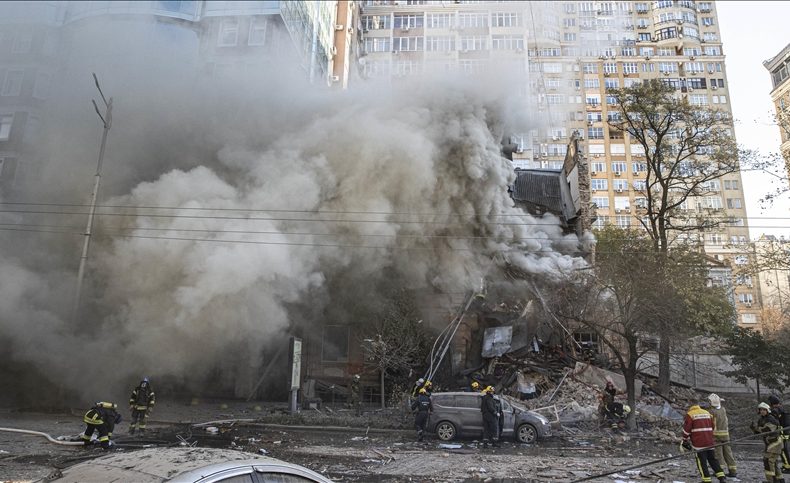
Russian Drone Strike Targets Ukraine: Latest Escalation in Conflict
Russian Drone Strike on Ukraine: A Surge in Tensions
A recent Russian drone strike on Ukraine has intensified the ongoing conflict, marking yet another significant escalation in a war that has already caused immense devastation and loss of life. The strike, which targeted critical infrastructure and military sites, has drawn widespread international condemnation and raised concerns over the growing use of unmanned aerial vehicles (UAVs) in modern warfare. As the situation continues to evolve, both military and civilian sectors in Ukraine face significant challenges, and the global community watches anxiously for the next steps.
Details of the Attack
The drone strike took place in the early hours of the morning, with several Russian drones striking key locations within Ukraine. Initial reports indicate that the target sites included military bases, communication infrastructure, and supply depots, which are critical to Ukraine’s defensive efforts. While Ukrainian forces worked quickly to intercept and neutralize some of the incoming drones, others successfully hit their intended targets, causing significant damage.
The attack is part of an ongoing pattern of increased drone usage in the conflict, with both Russia and Ukraine employing UAVs for reconnaissance, precision strikes, and supply drops. However, the scale and sophistication of the recent Russian drone strike indicate a shift in tactics, possibly signaling a new phase in the war. Ukrainian authorities have vowed to respond decisively, with President Volodymyr Zelensky condemning the assault and calling for increased international support.
Growing Use of Drones in the Conflict
Drones have become one of the defining technologies of the Russia-Ukraine conflict, with both sides using them for various strategic purposes. For Russia, drones offer a low-cost, high-impact weapon that can be deployed covertly and with precision. The use of drones allows Russian forces to strike at vital infrastructure without putting their own personnel at risk. On the Ukrainian side, drones have also played a significant role in defense efforts, from gathering intelligence to targeting Russian supply lines.
The increased reliance on drones in warfare raises several key issues, particularly concerning the safety of civilian populations and the potential for broader escalation. The recent Russian drone strike, which hit both military and civilian areas, underscores the challenges of distinguishing between combat zones and areas with non-combatants. The precision of drone strikes, while a tactical advantage, also brings the risk of unintended consequences, including civilian casualties and widespread destruction.
International Reactions and Implications
As the conflict intensifies, global reactions to the drone strike have been swift. NATO and other Western allies have condemned Russia’s continued aggression, calling for stronger measures to deter further attacks. At the same time, humanitarian organizations are expressing concern over the growing number of civilians affected by the violence, particularly as infrastructure targets become more frequent.
The international community has also voiced concerns about the future of the conflict. While many nations have provided military and economic support to Ukraine, the increasing frequency of drone strikes raises questions about the limitations of current defense systems and the potential for further escalation. Some experts warn that the use of drones may set a dangerous precedent for future conflicts, where smaller, more agile combatants can engage in highly targeted, asymmetric warfare without the need for large, conventional forces.
The Impact on Ukrainian Civilians
While the military ramifications of the Russian drone strike are significant, the human toll is also considerable. Ukrainian civilians continue to bear the brunt of the conflict, with each new wave of attacks causing more destruction in populated areas. The recent drone strike serves as a painful reminder of the vulnerability of everyday life in Ukraine, where people have lived under the constant threat of bombardment since the conflict began.
In addition to the physical damage, the psychological impact of repeated strikes is profound. Families in affected areas live in fear, unsure when the next attack will occur. The constant disruption of daily life, coupled with the loss of homes and loved ones, has left a lasting scar on the civilian population. Ukrainian authorities are working to provide shelter, medical care, and psychological support to those affected, but the long-term recovery from such traumatic events remains uncertain.
What’s Next for the Conflict?
The escalation of the Russian drone strike on Ukraine suggests that the conflict may be entering a more destructive phase. With both sides heavily invested in the use of advanced technologies, the war has evolved into a high-tech battle where traditional tactics are often overshadowed by the effectiveness of unmanned systems.
As the international community continues to call for peace negotiations, the reality on the ground is far from resolution. Ukraine remains determined to defend its sovereignty, while Russia shows no signs of backing down. The growing reliance on drones is likely to continue, and with it, the risk of further escalation. The coming weeks and months will be critical in determining how the war unfolds, and whether any diplomatic breakthroughs can be achieved to bring an end to the violence.